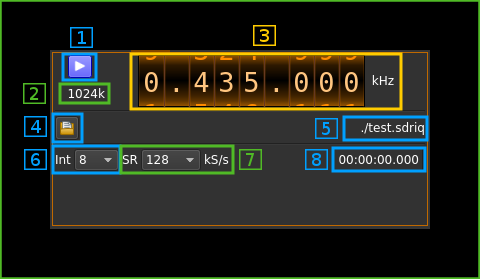File sink plugin
Introduction
This output sample sink plugin sends its samples to file in the SDRangel .sdriq format.
The format is S16LE I/Q samples. Thus there are 4 bytes per sample. I and Q values are 16 bit signed integers. The file starts with a context header containing information about center frequency, sample rate and timestamp of the start of the recording. This header has a length which is a multiple of a sample size (normally 24 bytes thus 6 samples). Thus this file can be used as a raw I/Q file with S16LE samples tolerating a glitch at the start corresponding to the 6 "random" samples. For example in GNURadio you can simply specify your file source format as short complex.
You can also zap the 24 bytes header with this Linux command: tail -c +25 myfile.sdriq > myfile.raw
To convert in another format you may use the sox utility. For example to convert to 32 bit (float) complex samples do: sox -r 48k −b 16 −e signed-integer -c 2 myfile.raw -e float -c 2 myfilec.raw
Note that you have to specify the sampling rate and use .raw for the file extensions.
Build
The plugin is always built.
Interface
1: Start/Stop
Device start / stop button.
- Blue triangle icon: device is ready and can be started
- Red square icon: device is running and can be stopped
- Magenta (or pink) square icon: an error occured
2: File stream sample rate
This is the file stream sample rate in kS/s after interpolation (4) from the baseband stream. Thus this is the sample rate (7) multiplied by the interpolation factor (6).
3: Frequency
This is the center frequency in kHz that will be put in the file header.
4: Output file selection
Use this file dialog to specify the output file.
5: File name
This is the file path of the output file.
6: Interpolation factor
The baseband stream is interpolated by this value before being written to file. It can vary in powers of two from 1 (no interpolation) to 64.
7: Baseband sample rate
This is the baseband sample rate before interpolation in kS/s. Possible values are: 32, 48, 64, 72, 128, 192, 256, 288, 300, 384, 512, 1000 kS/s.
8: Time counter
This is the recording time count in HH:MM:SS.SSS
